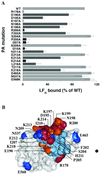Mapping the lethal factor and edema factor binding sites on oligomeric anthrax protective antigen
- PMID: 11997439
- PMCID: PMC124526
- DOI: 10.1073/pnas.062160399
Mapping the lethal factor and edema factor binding sites on oligomeric anthrax protective antigen
Abstract
Assembly of anthrax toxin complexes at the mammalian cell surface involves competitive binding of the edema factor (EF) and lethal factor (LF) to heptameric oligomers and lower order intermediates of PA(63), the activated carboxyl-terminal 63-kDa fragment of protective antigen (PA). We used sequence differences between PA(63) and homologous PA-like proteins to delineate a region within domain 1' of PA that may represent the binding site for these ligands. Substitution of alanine for any of seven residues in or near this region (R178, K197, R200, P205, I207, I210, and K214) strongly inhibited ligand binding. Selected mutations from this set were introduced into two oligomerization-deficient PA mutants, and the mutants were used in various combinations to map the single ligand site within dimeric PA(63). The site was found to span the interface between two adjacent subunits, explaining the dependence of ligand binding on PA oligomerization. The locations of residues comprising the site suggest that a single ligand molecule sterically occludes two adjacent sites, consistent with the finding that the PA(63) heptamer binds a maximum of three ligand molecules. These results elucidate the process by which the components of anthrax toxin, and perhaps other binary bacterial toxins, assemble into toxic complexes.
Figures



References
-
- Leppla S H. In: Bacterial Toxins and Virulence Factors in Disease. Moss J, Iglewski B, Vaughan M, Tu A T, editors. New York: Dekker; 1995. pp. 543–572.
-
- Confer D L, Eaton J W. Science. 1982;217:948–950. - PubMed
-
- Pellizzari R, Guidi-Rontani C, Vitale G, Mock M, Montecucco C. FEBS Lett. 1999;462:199–204. - PubMed
-
- Duesbery N S, Webb C P, Leppla S H, Gordon V M, Klimpel K R, Copeland T D, Ahn N G, Oskarsson M K, Fukasawa K, Paull K D, Woude G F V. Science. 1998;280:734–737. - PubMed
Publication types
MeSH terms
Substances
Grants and funding
LinkOut - more resources
Full Text Sources
Other Literature Sources

